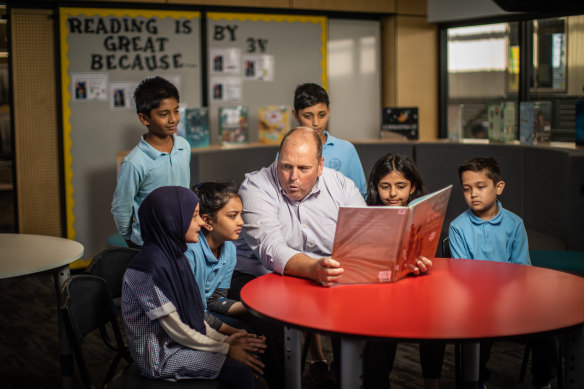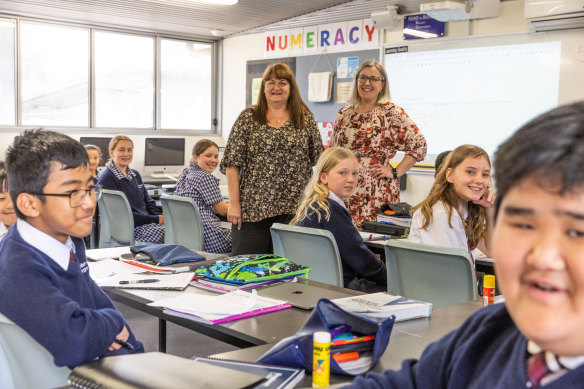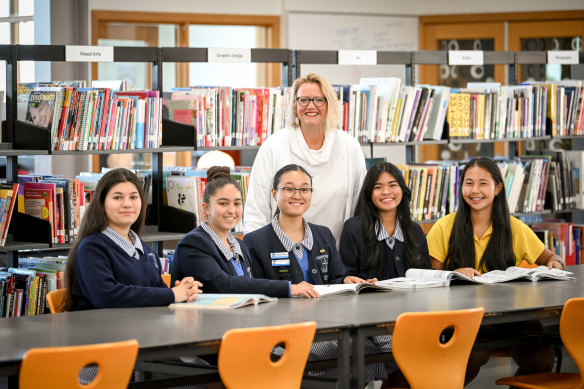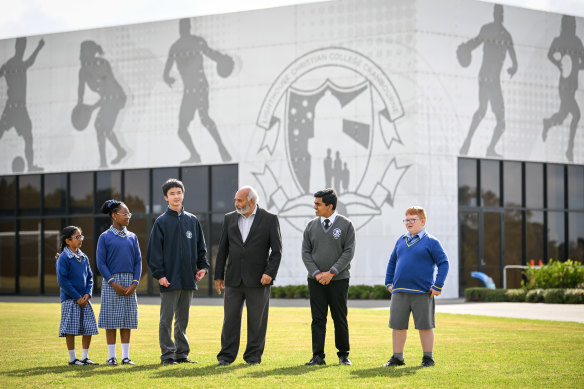Home » World News »
State schools dominate list of NAPLAN high achievers
The schools with Victoria’s best NAPLAN results over the past four years have been revealed, and government schools make up 16 of the state’s top-20 performers, alongside four schools in the independent and Catholic sectors.
Schools with a high proportion of students from first-generation migrant families also dominated the list of high achievers. Between 60 per cent and 90 per cent of students were from non-English-speaking backgrounds in every school in the top 10.
Dandenong North Primary School principal Paul Hilton with year 5 students. Credit:Scott McNaughton
Two of the four non-government schools in the top 20 are low-fee, outer suburban schools and two are high-fee schools. Two are also all-girls schools.
Schools in less advantaged communities including Dandenong, St Albans, Springvale and Braybrook registered heavily in the top 20, including the school with the best NAPLAN results in the state.
Dandenong North Primary, a public school in Melbourne’s south-east where 70 per cent of pupils are classified as disadvantaged, has the best NAPLAN results in Victoria, data from the Australian Curriculum and Assessment Authority shows.
It is the only school in the state where students in all year levels that were tested made progress that was well above average every year that NAPLAN was conducted between 2019 and 2022 in all five domains: reading, writing, spelling, grammar and numeracy.
The NAPLAN results for 2022 were published on the MySchool website on Wednesday, along with information on each school’s profile, population and attendance levels last year.
Australian students sit NAPLAN in years 3, 5, 7 and 9, and their results and progress in the standardised test are compared against other similar students around the country.
Ordinarily, students’ progress in the five fields would have been assessed by comparing their results last year with their results in 2020. But the standardised test of students’ literacy and numeracy proficiency was cancelled in 2020, prompting the Curriculum and Assessment Authority to assess last year’s NAPLAN results over three of the past four years to identify top-performing schools.
Glenn Fahey, education program director at the Centre for Independent Studies, said it should not be surprising that government schools filled most places on the list.
He said state schools routinely performed as well as, or better than, non-government schools on standardised tests such as NAPLAN and PISA.
“At a macro level, one of the unspoken findings in the data year-on-year is that … government schools do hold their own on average,” Fahey said.
“State schools do really well and unfortunately that gets sometimes buried in simplistic analysis. But when you compare similarly advantaged schools, I think public schools on the whole can be really proud of their efforts.”
Julie Sonnemann, the education lead at Impact Economics, said research into student progress had found that once a student’s background was factored in, there was minimal difference in performance between public and private schools.
Previous research she conducted for the Grattan Institute found the average progress made by students in private schools was about one month greater than that of public school students over two years at primary school level, and two months greater in secondary schools.
“When you control for socioeconomic status, there is minimal value-add in terms of the extra learning that happens [in non-government schools],” Sonnemann said.
Dandenong North Primary School principal Paul Hilton credited the school’s strong results to consistent leadership, data-driven explicit teaching, tutoring, intervention and extension programs. He said the school also sought to be a second home for students.
Of the 811 students at the school, 89 per cent come from non-English-speaking backgrounds, including 38 per cent from Afghanistan.
Over the past five years on average, about 95 per cent of year 3 and 5 students have sat NAPLAN, as some students enter the school with limited English and go through an intensive 12-month English language program, Hilton said.
He said the school was lucky to be well funded, with lots of intervention and extension programs.
Prep to year 3 students who are below benchmarked reading levels can go through their “language factory”, which is 45 minutes a day focusing on phonics and decoding words.
Braybrook College, in Melbourne’s west, has a near-identical profile to Dandenong North, with 85 per cent of students from non-English speaking backgrounds and 80 per cent of students classified as disadvantaged.
Braybrook College principal Kelly Panousieris (left) and maths co-ordinator Rebecca Thom in the school’s numeracy centre. Credit:Jason South
It was the best secondary school in the state in NAPLAN testing between 2019 and 2022.
Principal Kelly Panousieris said the school poured extra time and resources into its students’ English literacy. Every year 7 and 8 student is required to take four dedicated literacy classes a week, on top of standard English classes.
“We have children who are refugee children, so once they leave school they don’t pick up a book, or certainly not a book in English,” Panousieris said.
The school’s low socioeconomic status entitles it to more equity funding, and it directs this money to literacy and a numeracy centre, where students who are struggling in maths attend lunchtime sessions.
Killester College in Springvale is the only Catholic school, and one of two girls’ schools, in the top 20. Students’ input is valued so highly that they help unpack NAPLAN data and are on interview panels for new teachers, principal Sally Buick said.
Killester College principal Sally Buick with students, some of whom are involved in interviewing prospective teachers. Credit:Eddie Jim
The school’s emphasis on student voice was one of the reasons the low-fee, multicultural school was one of the best-performing schools in NAPLAN results over the past four years, relative to socio-educational advantage, she said.
During the pandemic, Killester College created an inquiry-based learning program called Wonder, which has led to projects such as a tampon dispenser at the school.
“What it teaches our young people is to be independent thinkers, not just soakers up of information,” Buick said.
“I think that will always show in NAPLAN results because it means your kids are able to think differently and apply critical thinking skills to stuff.”
Buick said staff were constantly seeking students’ input.
Some teacher candidates “flip out” when Buick tells them a student will be involved in interviewing them, but students complete training before the interview and discuss what the school is looking for and why it’s important.
Lighthouse Christian College is one of three independent schools on the list. Principal Jacob Mathews said it provided free after-school and holiday tuition and had a strong focus on character development.
Lighthouse Christian College Cranbourne principal Jacob Mathews, pictured with students, says the school uses the Bible to teach its students to read English. Credit:Eddie Jim
The low-fee independent school in Cranbourne expects students to do daily homework, Bible reading and comprehension questions from year 2.
The P-12 college has about 1000 students, 90 per cent of whom are from culturally and linguistically diverse communities.
NAPLAN co-ordinator Teresa Simon said teachers had a strong focus on the students’ character and attitudes, along with strong links with parents.
“Teachers realise the importance of a disciplined work environment and enforce strict classroom and work expectations,” she said.
The Morning Edition newsletter is our guide to the day’s most important and interesting stories, analysis and insights. Sign up here.
Most Viewed in National
From our partners
Source: Read Full Article






